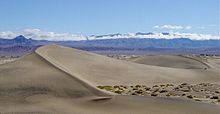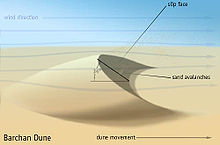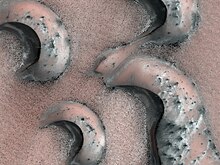Sickle dune
The barchan or Barchan sometimes, Transversaldüne called, is a very common, transversely to the wind flow forming dunes form , which in almost all desert areas found on earth. It arises when there is a relatively low supply of sand (Mangeldüne), but requires a constant wind direction . Its convex, flat side faces the wind. Sickle dunes should not be confused with parabolic dunes, which are organized in exactly the opposite way .
etymology
The German name Sicheldüne is derived from the characteristic sickle shape. The Kazakh term Barchan ( бархан ; barhan) was introduced via Russian ( бархан ; barchán) in 1881 by the Russian naturalist Alexander Theodor von Middendorff . Transverse dune refers to the transverse position to the wind.
Origin and description
Sickle dunes begin as small, oval patches of sand on a stony, paved, contiguous surface with relatively little sand. This initial structure then slowly gaining height and then goes through the stages Protodüne with wind ripples followed by by grain jump (Engl. Grain case ) characterized, dome-like Protodüne . After insertion of the aerodynamic flow separation ( English flow separation ), formed in Lee the dune a Abrutschseite (engl. Slip face ), with the angle of friction of dry of medium to fine-grained sand is incident (30 ° to 35 °) and by grain sliding ( English grainflow ). The side facing the wind ( windward slope ) is much flatter due to the wind pressure and has an angle of incidence of around 15 °. As soon as the sand accumulation reaches 30 centimeters in height, sickle dunes begin to migrate downwind.
A fully mature crescent dune in itself has, i. That is, separated from the influence of any neighbors, bilateral symmetry in plan with a characteristic, crescent-shaped outline. Its elevation is decidedly asymmetrical with a long, slowly rising windward slope and a shorter, much steeper lee side. The two pointed sickle ends, often also called arms , horns or wings , point downwind. They enclose a curved central part in which a steep slide side has formed below a narrow slide edge due to sand avalanches . The parabolic curved dune ridge slowly descends towards the sickle ends. As the sickle ends move faster than the main ridge of the dune, the characteristic curved sickle shape is created. The reason for the faster migration of the side arms is the lower sand mass that has to be circulated by the wind, as well as the increased transport rate, which can be attributed to lower intergranular friction and thus easier rebound of the grains .
Dimensions

Usually sickle dunes reach heights of 2 to 20 meters and behave relatively to scale within a region. Extreme heights of 50 meters, however, have become known; these dunes then develop parasitic transverse structures. Maxima in the height distribution are usually located at 4 meters and 8 to 10 meters. The average width of sickle dunes is 50 meters, but in exceptional cases they can be up to 370 meters wide. Their length is similar to the width with an average of 50 to 100 meters and, in rare cases, up to 225 meters.
Modified forms
Crescent dunes can be compacted by wind pressure, which in turn leads to deviations from the ideal aerodynamic shape . Their sliding edges bend, the sickle ends become asymmetrical, whereby one wing can grow faster than the other. Sickle dunes that are close together often combine to form a V-formation , which is very similar to migratory bird formations. Sand is preferably blown off the wings, so they rush forward. The reason for this lies in a reduced shear stress close to the ground and in a convergence of the wind flow in the lee of the sickle ends. Migratory birds save energy by staggering them, as they fly in the upwelling edge of the wake of their predecessors.
Usually a sickle horn grows preferentially, so that finally there is a transition to pearl soap dunes. There are two basic types:
- According to Bagnold, drawn out sickle ends are created by very strong cross winds that start at an angle of around 45 °.
- According to Tsoar, these cross winds are relatively weak and, moreover, only blow seasonally.
The two resulting dune shapes look very different, since in Bagnold's model there are clear windward sides in the extended tips, but are not realized in Tsoar.
In dune fields, sickle dunes usually appear as groups of individual forms. You can also form chains that line up in the direction of the wind. As the supply of sand increases, individual forms often grow together to form giant barchans or - across the direction of the wind - barchanoid or even giant barchanoid backs. The latter two forms are created by merging side-by-side crescent dunes. The backs can stretch for hundreds of kilometers and are in turn often covered by parasitic, small sickle dunes. The size distribution in a dune field is regulated by collisions of individual dunes and changes in the wind direction, which create new sickle dunes from the horns of their predecessors.
Locomotion
Sickle dunes are free dunes ( shifting dunes ) and migrate downwind over rocks, immovable gravel pavement and coarse sand (over so-called regs ). In sickle dune fields there is no or extremely patchy vegetation, as their movement would otherwise be hindered. The speed of their movement has already been studied and modeled in numerous scientific papers. In general, sickle dunes move at an average speed of 10 to 20 meters per year or 0.317 to 0.634 × 10 −6 meters per second. Measured peak values are 70 meters per year or 2.22 × 10 −6 meters per second. The speed is inversely proportional to the dune height, i.e. That is, low dunes migrate faster than high ones. So measured Fryberger u. a. (1984) in Saudi Arabia for 2.9 meter high dunes 39 meters per year and for 23 meter high dunes 5 meters per year.
During the movement there is intensive sorting of the sediment according to grain size , grain shape and density . Large grains then tend to accumulate on the wings, on the edges or in the crest area of the sickle dune. Heavy grains are concentrated at the upwind end, whereas very fine-grained quartz sands form rippled sand surfaces on the downstream side .
In dune fields you can see how small sickle dunes move faster than their larger counterparts. The small forms then close to the windward side of their predecessors, literally penetrate them and then reappear on the lee side. On the surface, this process is similar to the penetration process of light, sound or water waves, which, however, is different in detail. The sickle dunes seem to mimic the behavior of solitons . Solitons, however, penetrate a medium without disturbing it significantly (in the case of water waves, for example, the position of the individual molecules changes only minimally), whereas in the sickle dunes the sand grains are rearranged and the individual sand grains are actually moved. As soon as the faster small form reaches its large precursor, sand is deposited on its windward side. At the same time, sand is blown off the crest of the precursor without being replaced. Over time, the windward side then grows to the height of the original large dune. The front part, which has been blown away, is now organized into a faster, smaller shape, which eventually detaches completely and moves on with the wind.
Influence of the wind speed
An increase in the wind speed increases the height of the sickle dune, but at the same time the curvature of the dune ridge decreases.
Internal structure
In their internal structure, sickle dunes show a characteristic oblique stratification , comparable to dunes deposited under water but of larger dimensions. The oblique stratification is organized in flat, board-like, 1 to 2 meter thick packages, which are separated from one another by areas of discordance . In contrast to wedge-shaped packages, this indicates relatively constant wind conditions. Horizontal packets of layers also occur, particularly in the ridge region and on the windward side of the dune. Due to the avalanche-like sliding on the lee side, synsedimentary deformation structures are quite common. The maximum angles of incidence of the sediment layers reach 34 °. In the central part of the sickle dune, the scatter of the directions of incidence from the main wind direction usually remains below 45 °, in contrast to soap dunes , which can scatter up to 90 °. The sickle horns are a transitional case, as they already take on the characteristics of soap dunes due to their elongation. Their variable layer incidence shows that there are secondary currents in their area: on the one hand vortex systems with a vertical axis or horizontal spiral currents.
Occurrence
Sickle dunes are found in all desert areas of the world, the only exception is, strangely, Australia . They occur:
- In the Sahara .
- In the deserts of Arabia .
- In the deserts of Iran .
- In the arid basins of Central Asia .
- In the arid regions of East and South Africa .
- In the southwestern United States .
- In the desert of Peru .
Sickle dunes have also been observed in coastal regions of the temperate zones. Sickle dunes could even establish themselves on the sandbanks of larger rivers. Examples of other planets and moons are also known. B. sickle dune fields in the Olympia Undae or in the Hellespontus dunes on the planet Mars .
Sickle dunes are not only formed from sand, but also arise in granular snow that is driven over ice surfaces. They are not only bound to the medium of air , they are also deposited in water . Examples are sickle dunes made of foraminiferous sand that were transported to the sea floor in several thousand meters of water. They are also found in rivers , in shallow tidal channels, in estuaries and in other ocean currents. They can also be generated experimentally by applying relatively sparse transportable sediment to surfaces made of glass, clay or fine silt.
literature
- JRL Allen: Sedimentary Structures - Their Character and Physical Basis . In: Developments in Sedimentology . tape 30 . Elsevier, 1984, ISBN 0-444-42232-3 .
Individual evidence
- ^ GA Worrall: Observations on some wind-formed features in the southern Sahara . In: Journal of Geomorphology . tape 18 , no. 3 , 1974, p. 291-302 .
- ↑ G. Kocurek et al. a .: Dune and dunefield development on Padre Island, Texas, with implications for interdune deposition and water-table-controlled accumulation . In: Journal of Sedimentary Petrology . tape 62 , 1992, pp. 622-635 .
- ↑ MR Leeder: Sedimentology and Sedimentary Basins: from turbulence to tectonics . Blackwell Science, 1999, ISBN 0-632-04976-6 , pp. 592 .
- ↑ H. Tsoar: Desert dunes morphology and dynamics: El-Arish (Northern Sinai) . In: Journal of Geomorphology . tape 20 , 1974, p. 41-61 .
- ^ EA Shinn: The Persian Gulf . Ed .: BH Purser. Springer, Berlin 1973, p. 199-209 .
- ↑ a b R. A. Bagnold: The Physics of Blown Sand and Desert Dunes . 2nd Edition. Methuen, London 1954, p. 265 .
- ↑ H. Tsoar: Dynamic processes acting on a longitudinal (seif) sand dune . In: Sedimentology . tape 30 , 1983, pp. 567-578 .
- ↑ CS Breed: Terrestrial analogs of the hellespontus dunes, Mars . In: Icarus . tape 30 , 1977, pp. 326-340 .
- ↑ H. Elbelrhiti, P. and B. Claudin Andreotti: Field evidence for surface-wave-induced instability of sand dunes . In: Nature . tape 437 , 2005, pp. 720-723 , doi : 10.1038 / nature04058 .
- ↑ P. Gay: Origen, distribucion y movimiento de las arenas eolicas en el area de Yauca a Palpa . In: Bol. Soc. Geol. Peru . tape 37 , 1962, pp. 37-58 .
- ↑ SG Fryberger u. a .: Wind sedimentation in the Jafurah sand sea, Saudi Arabia . In: Sedimentology . tape 31 , 1984, pp. 805-821 .
- ^ A b R. L. Hay: Geology of the Olduvai Gorge: a Study of Sedimentation in a Semiarid Basin . University of California Press, Berkeley & Los Angeles, Calif. 1976.
- ^ V. Schwämmle, HJ Herrmann: Solitary wave behavior of sand dunes . In: Nature . tape 426 , 2003, p. 619-620 , doi : 10.1038 / 426619a .
- ^ AD Howard et al. a .: Sand transport model of barchan dune equilibrium . In: Sedimentology . tape 25 , 1978, pp. 307-338 .
- ↑ a b J. RL Allen: Principles of Physical Sedimentology . Chapman & Hall, London 1985, ISBN 0-412-53090-2 , pp. 272 .
- ^ MI Whitney: The role of vorticity in developing lineation by wind erosion . In: Geol. Soc. Amer. Bull. Band 89 , 1978, pp. 1-18 .
- ^ V. Cornish: Waves of Sand and Snow . Fisher Unwin, London 1914.
- ^ MP Petrov, MP: Deserts of the World . Wiley, New York, NY 1976.
- ↑ K. Gripp and L. Martens: When nature plays in the sand . Publishing house of the Society of Friends of the Fatherland Schools and Education System, Hamburg 1963.
- ^ G. Seligman, G .: Snow Structure and Ski Fields . Macmillan, London 1936.
- ↑ I. Karcz: Fluvial Geomorphology . Ed .: M. Morisawa. State University of New York, Binghamton, NY 1974, pp. 149-173 .



